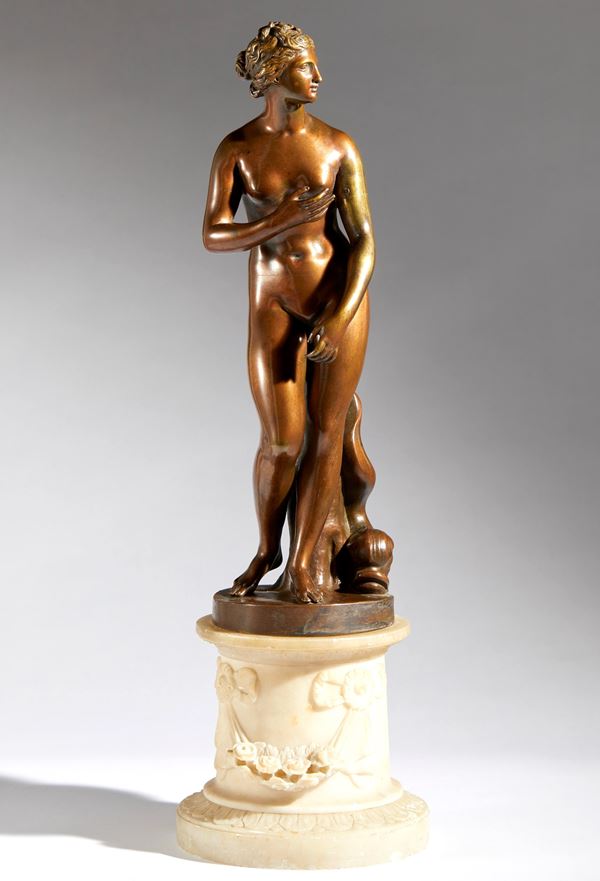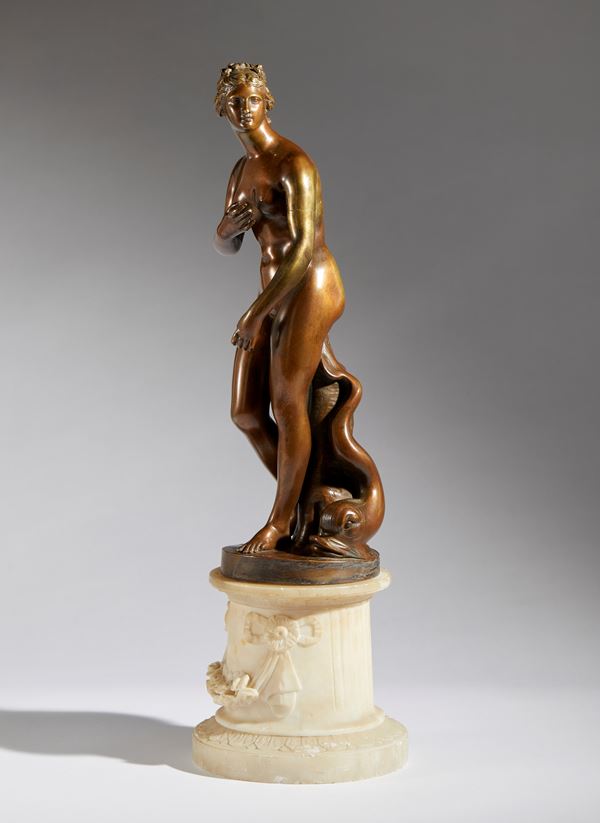28
Venus de' Medici, from the archaeological model, Tuscan School, 18th-19th century
Patinated bronze with translucent reddish tones; 52x16x16 cm. On base 37.5 x 11 x 11.5 cm
The bronze statuette examined here derives from the famous marble sculpture kept in the Uffizi Museum in Florence, called Venus Medici or Venus Pudica. This is a Roman copy from the 2nd century AD of a Greek original in bronze from the 1st century BC. Being one of the most appreciated and discovered classical sculptures of the Renaissance period, of which there are certain documents only from the 17th century, it was the object of small-scale copies from its origins to the present day. The most famous bronze version, accompanied by other reproductions of classical sculptures so popular at the time, was undoubtedly the one made by the great Tuscan sculptor Massimiliano Soldani Benzi (Montevarchi 1656-1740) today preserved in Vaduz in the collection of the princes of Liechtenstein.
The splendid transparent patina, with golden reddish tones, typical of the best Tuscan tradition from Giambologna onwards, testifies to the antiquity of this artefact.
Bibl. Eike D. Shmidt, Sandro Bellesi, Riccardo Gennaioli, Shaped by Fire, exhibition catalogue, Le Sillabe ed., Livorno, 2019, pp.64-66, 298-99, 306-309
The bronze statuette examined here derives from the famous marble sculpture kept in the Uffizi Museum in Florence, called Venus Medici or Venus Pudica. This is a Roman copy from the 2nd century AD of a Greek original in bronze from the 1st century BC. Being one of the most appreciated and discovered classical sculptures of the Renaissance period, of which there are certain documents only from the 17th century, it was the object of small-scale copies from its origins to the present day. The most famous bronze version, accompanied by other reproductions of classical sculptures so popular at the time, was undoubtedly the one made by the great Tuscan sculptor Massimiliano Soldani Benzi (Montevarchi 1656-1740) today preserved in Vaduz in the collection of the princes of Liechtenstein.
This masterpiece was made in pair with the Dancing Faun, which is also kept in Florence, for Prince JAA von Liechtenstein in 1695 and measures 158 cm. This extraordinary bronze features the typical Tuscan patinas, much appreciated at the time of Giambologna and his school, of a translucent golden color tending towards red.
The chisel finishing is obviously also at the highest levels of the Florentine school. Obviously, there are other reproductions of the same subject made by great bronze sculptors up to the neoclassical era and beyond, among all we remember the version by Pietro Cipriani (Florence 1678-1745), 155.3 cm high with the variant without the dolphin, but with a putto at the feet of the goddess. Returning to the small bronze Venus examined here, we can place it in the archaeological vein mentioned above. In my opinion, it is an eighteenth-century casting with beautiful resolution in the modeling of the body, which maintains the sensual realism of the marble original. In particular, the breasts, buttocks and legs describe a female body in an extremely realistic way.
The splendid transparent patina, with golden reddish tones, typical of the best Tuscan tradition from Giambologna onwards, testifies to the antiquity of this artefact.
Our bronze is mounted on a beautiful neoclassical alabaster pedestal.
Bibl. Eike D. Shmidt, Sandro Bellesi, Riccardo Gennaioli, Shaped by Fire, exhibition catalogue, Le Sillabe ed., Livorno, 2019, pp.64-66, 298-99, 306-309
Live auction 329
Placquettes, Medals, Sculptures and Ceramics from the 14th to the 19th century
Palazzo Caetani Lovatelli, wed 5 March 2025
SINGLE SESSION 05/03/2025 Hours 15:00
Discover Similar Lots


















